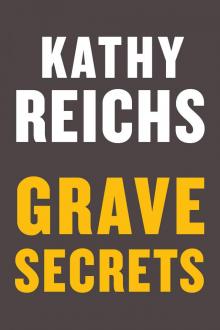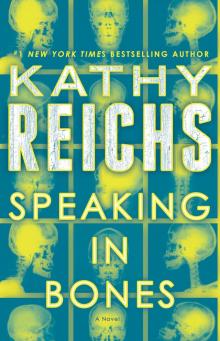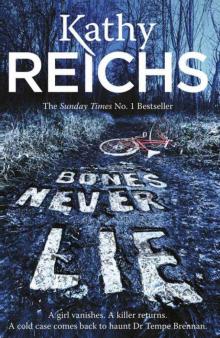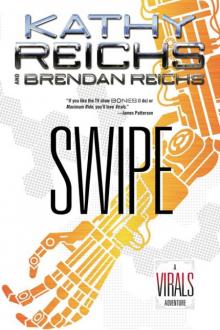- Home
- Kathy Reichs
Devil Bones
Devil Bones Read online
ALSO BY KATHY REICHS
BONES TO ASHES
BREAK NO BONES
CROSS BONES
MONDAY MOURNING
BARE BONES
GRAVE SECRETS
FATAL VOYAGE
DEADLY DÉCISIONS
DEATH DU JOUR
DÉJÀ DEAD
SCRIBNER
A Division of Simon & Schuster, Inc.
1230 Avenue of the Americas
New York, NY 10020
This book is a work of fiction. Names, characters, places, and incidents either are products of the author’s imagination or are used fictitiously. Any resemblance to actual events or locales or persons, living or dead, is entirely coincidental.
Copyright © 2008 by Temperance Brennan, L.P.
All rights reserved, including the right to reproduce this book or portions thereof in any form whatsoever. For information address Scribner Subsidiary Rights Department, 1230 Avenue of the Americas, New York, NY 10020.
SCRIBNER and design are registered trademarks of The Gale Group, Inc., used under license by Simon & Schuster, Inc., the publisher of this work.
Library of Congress Control Number: 2008013676
ISBN-13: 978-1-4165-7983-0
ISBN-10: 1-4165-7983-4
Visit us on the World Wide Web:
http://www.SimonSays.com
Dedicated to
Police Officer Sean Clark
November 22, 1972–April 1, 2007
and
Police Officer Jeff Shelton
September 9, 1971–April 1, 2007
And to all who have died protecting the citizens of
Charlotte-Mecklenburg, North Carolina
Sergeant Anthony Scott Futrell
July 17, 2002
Police Officer John Thomas Burnette
October 5, 1993
Police Officer Anthony A. Nobles
October 5, 1993
Patrol Officer Eugene A. Griffin
November 22, 1991
Police Officer Milus Terry Lyles
August 6, 1990
Police Officer Robert Louis Smith
January 15, 1987
Patrol Officer Timothy Wayne Whittington
July 16, 1985
Patrol Officer Ernest Coleman
July 1, 1982
Patrol Officer Edmond N. Cannon
November 23, 1981
Officer Ronnie E. McGraw
October 18, 1970
Sergeant Lewis Edward Robinson, Sr.
May 4, 1970
Police Officer Johnny Reed Annas
May 21, 1960
Detective Charlie Herbert Baker
April 12, 1941
Officer Rufus L. Biggers
February 12, 1937
Officer Charles P. Nichols
April 17, 1936
Patrol Officer Benjamin H. Frye
June 9, 1930
Detective Thomas H. Jenkins
October 21, 1929
Officer William Rogers
August 30, 1929
Detective Harvey Edgar Correll
January 22, 1929
Patrol Officer Robert M. Reid
January 1, 1927
Rural Police Officer John Franklin Fesperman
February 16, 1924
Officer John Robert Estridge
March 29, 1913
Rural Police Officer Sampson E. Cole
January 1, 1905
Officer James H. Brown
August 2, 1904
Patrol Officer James Moran
April 4, 1892
ACKNOWLEDGMENTS
Thanks go to Dr. Richard L. Jantz, statistical guru behind Fordisc 3.0; to Dr. M. Lee Goff, a most excellent bug guy (his real name is Madison); to Dr. Peter Dean, coroner extraordinaire; and to Dr. William C. Rodriguez, one of the wisest forensic anthropologists in the kingdom. Dr. Leslie Eisenberg, Dr. Norm Sauer, and Dr. Elizabeth Murray also gave input on bone minutiae.
Sergeant Darrell Price, Sergeant Harold (Chuck) Henson, and Detective Christopher Dozier, Charlotte-Mecklenburg Police Department, answered cop questions. Mike Warns shared knowledge and opinions on many things. What he didn’t know, he found out.
Dr. Wayne A. Walcott, Senior Associate Provost, UNC-Charlotte, provided information on the availability of scanning electron microscopes on campus. UNCC has five. Who knew?
I appreciate the continued support of Chancellor Philip L. Dubois of the University of North Carolina–Charlotte.
I am grateful to my family for their patience and understanding, especially when I am grumpy. Or away. Special thanks must go to my daughter, Kerry, who took time to discuss my book while writing her own. (Yay! First novel: The Best Day of Someone Else’s Life, available the spring of 2008!) Extra credit to Paul Reichs for reading and commenting on the manuscript.
Deepest thanks to my awesome agent, Jennifer Rudolph Walsh; to my brilliant editors, Nan Graham and Susan Sandon; and to my magnificent publisher, Susan Moldow. Thanks to Kevin Hanson and Amy Cormier in Canada. I also want to acknowledge all those who work so very hard on my behalf, especially: Katherine Monaghan, Lauretta Charlton, Anna deVries, Anna Simpson, Claudia Ballard, Jessica Almon, Tracy Fisher, and Michelle Feehan.
If there are errors in this book, they are my fault. If I have forgotten to thank someone, I apologize.
DEVIL BONES
1
MY NAME IS TEMPERANCE DEASSEE BRENNAN. I’M FIVE-FIVE, feisty, and forty-plus. Multidegreed. Overworked. Underpaid.
Dying.
Slashing lines through that bit of literary inspiration, I penned another opening.
I’m a forensic anthropologist. I know death. Now it stalks me. This is my story.
Merciful God. Jack Webb and Dragnet reincarnate.
More slashes.
I glanced at the clock. Two thirty-five.
Abandoning the incipient autobiography, I began to doodle. Circles inside circles. The clock face. The conference room. The UNCC campus. Charlotte. North Carolina. North America. Earth. The Milky Way.
Around me, my colleagues argued minutiae with all the passion of religious zealots. The current debate concerned wording within a subsection of the departmental self-study. The room was stifling, the topic poke-me-in-the-eye dull. We’d been in session for over two hours, and time was not flying.
I added spiral arms to the outermost of my concentric circles. Began filling spaces with dots. Four hundred billion stars in the galaxy. I wished I could put my chair into hyperdrive to any one of them.
Anthropology is a broad discipline, comprised of linked subspecialties. Physical. Cultural. Archaeological. Linguistic. Our department has the full quartet. Members of each group were feeling a need to have their say.
George Petrella is a linguist who researches myth as a narrative of individual and collective identity. Occasionally he says something I understand.
At the moment, Petrella was objecting to the wording “reducible to” four distinct fields. He was proposing substitution of the phrase “divisible into.”
Cheresa Bickham, a Southwestern archaeologist, and Jennifer Roberts, a specialist in cross-cultural belief systems, were holding firm for “reducible to.”
Tiring of my galactic pointillism, and not able to reduce or divide my ennui into any matters of interest, I switched to calligraphy.
Temperance. The trait of avoiding excess.
Double order, please. Side of restraint. Hold the ego.
Time check.
Two fifty-eight.
The verbiage flowed on.
At 3:10 a vote was taken. “Divisible into” carried the day.
Evander Doe, department chair for over a decade, was presiding. Though roughly my age, Doe looks like someone out of a Grant Wood painting. Bald. Ow
lish wire-rims. Pachyderm ears.
Most who know Doe consider him dour. Not me. I’ve seen the man smile at least two or three times.
Having put “divisible into” behind him, Doe proceeded to the next burning issue. I halted my swirly lettering to listen.
Should the department’s mission statement stress historical ties to the humanities and critical theory, or should it emphasize the emerging role of the natural sciences and empirical observation?
My aborted autobiography had been smack on. I would die of boredom before this meeting adjourned.
Sudden mental image. The infamous sensory deprivation experiments of the 1950s. I pictured volunteers wearing opaque goggles and padded hand muffs, lying on cots in white-noise chambers.
I listed their symptoms and compared them to my present state.
Anxiety. Depression. Antisocial behavior. Hallucination.
I crossed out the fourth item. Though stressed and irritable, I wasn’t hallucinating. Yet. Not that I’d mind. A vivid vision would have provided diversion.
Don’t get me wrong. I’ve not grown cynical about teaching. I love being a professor. I regret that my interaction with students seems more limited each year.
Why so little classroom time? Back to the subdiscipline thing.
Ever try to see just a doctor? Forget it. Cardiologist. Dermatologist. Endocrinologist. Gastroenterologist. It’s a specialized world. My field is no different.
Anthropology: the study of the human organism. Physical anthropology: the study of the biology, variability, and evolution of the human organism. Osteology: the study of the bones of the human organism. Forensic anthropology: the study of the bones of the human organism for legal purposes.
Follow the diverging branches, and there I am. Though my training was in bioarchaeology, and I started my career excavating and analyzing ancient remains, I shifted into forensics years ago. Crossed to the dark side, my grad school buddies still tease. Drawn by fame and fortune. Yeah, right. Well, maybe some notoriety, but certainly no fortune.
Forensic anthropologists work with the recently dead. We’re employed by law enforcement agencies, coroners, medical examiners, prosecutors, defense attorneys, the military, human rights groups, and mass-disaster recovery teams. Drawing on our knowledge of biomechanics, genetics, and skeletal anatomy, we address questions of identification, cause of death, postmortem interval, and postmortem alteration of the corpse. We examine the burned, decomposed, mummified, mutilated, dismembered, and skeletal. Often, by the time we see remains, they’re too compromised for an autopsy to yield data of value.
As an employee of the state of North Carolina, I’m under contract to both UNC-Charlotte, and to the Office of the Chief Medical Examiner, which has facilities in Charlotte and Chapel Hill. In addition, I consult for the Laboratoire de sciences judiciaires et de médecine légale in Montreal.
North Carolina and Quebec? Extraordinaire. More on that later.
Because of my cross-border treks and my dual responsibilities within North Carolina, I teach only one course at UNCC, an upper-level seminar in forensic anthropology. This was my biannual semester in the classroom.
And the conference room.
I look forward to the teaching. It’s the interminable meetings that I detest. And the faculty politics.
Someone moved that the mission statement be returned to committee for further study. Hands rose, mine among them. As far as I was concerned, the thing could be sent to Zimbabwe for permanent interment.
Doe introduced the next agenda item. Formation of a committee on professional ethics.
Inwardly groaning, I began a list of tasks requiring my attention.
1. Specimens to Alex.
Alex is my lab and teaching assistant. Using my selections, she would set up a bone quiz for the next seminar.
2. Report to LaManche.
Pierre LaManche is a pathologist, and chief of the medico-legal section at the LSJML. The last case I’d done before leaving Montreal the previous week was one of his, an auto-fire victim. According to my analysis, the charred corpse was that of a thirty-something white male.
Unfortunately for LaManche, the presumed driver should have been a fifty-nine-year-old Asian female. Unfortunately for the victim, someone had pumped two slugs into his left parietal. Unfortunately for me, the case was a homicide and would probably require my presence in court.
3. Report to Larabee.
Tim Larabee is the Mecklenburg County medical examiner, and director of the three-pathologist Charlotte facility. His had been the first case I’d done upon returning to North Carolina, a bloated and decomposed lower torso washed up on the shore of the Catawba River. Pelvic structure had indicated the individual was male. Skeletal development had bracketed the age between twelve and fourteen. Healed fractures of the right fourth and fifth metatarsals had suggested the possibility of an ID from antemortem hospital records and X-rays, if such could be found.
4. Phone Larabee.
Arriving on campus today, I’d found a two-word voice mail from the MCME: Call me. I’d been dialing when Petrella came to drag me into the meeting from hell.
When last we’d spoken, Larabee had located no missing person reports that matched the Catawba River vic’s profile. Perhaps he’d now found one. I hoped so, for the sake of the family. And the child.
I thought of the conversation Larabee would have with the parents. I’ve had those talks, delivered those life-shattering pronouncements. It’s the worst part of my job. There is no easy way to tell a mother and father that their child is dead. That his legs have been found, but his head remains missing.
5. Sorenstein recommendation.
Rudy Sorenstein was an undergraduate with hopes of continuing his studies at Harvard or Berkeley. No letter from me was going to make that happen. But Rudy tried hard. Worked well with others. I’d give his mediocre GPA the best spin possible.
6. Katy shopping.
Kathleen Brennan Petersons is my daughter, living in Charlotte as of this fall, employed as a researcher in the public defender’s office. Having spent the previous six years as an undergraduate at the University of Virginia, Katy was desperately in need of clothes made of fabric other than denim. And of money to buy them. I’d offered to serve as fashion consultant. There’s irony. Pete, my estranged husband, was functioning as ways and means.
7. Birdie litter.
Birdie is my cat. He is fussy concerning matters of feline toilette, and expresses his displeasure in ways I try to prevent. Inconveniently, Birdie’s preferred litter brand is available only in veterinary offices.
8. Dental checkup.
The notification had been delivered with yesterday’s mail.
Sure. I’d get right on that.
9. Dry cleaning.
10. Car inspection.
11. Shower door handle.
I sensed, more than heard, an odd sound in the room. Stillness.
Glancing up, I realized attention was focused on me.
“Sorry.” I shifted a hand to cover my tablet. Casually.
“Your preference, Dr. Brennan?”
“Read them back.”
Doe listed what I assumed were three hotly contested names.
“Committee on Professional Responsibility and Conduct. Committee on the Evaluation of Ethical Procedures. Committee on Ethical Standards and Practices.”
“The latter implies the imposition of rules set by an external body or regulating board.” Petrella was doing petulant.
Bickham threw her pen to the tabletop. “No. It does not. It is simp—”
“The department is creating an ethics committee, right?”
“It’s critical that the body’s title accurately reflect the philosophical underpinnings—”
“Yes.” Doe’s reply to my question cut Petrella off.
“Why not call it the Ethics Committee?”
Ten pairs of eyes froze on my face. Some looked confused. Some surprised. Some offended.
Petrel
la slumped back in his chair.
Bickham coughed.
Roberts dropped her gaze.
Doe cleared his throat. Before he could speak, a soft knock broke the silence.
“Yes?” Doe.
The door opened, and a face appeared in the crack. Round. Freckled. Worried. Twenty-two curious eyes swiveled to it.
“Sorry to interrupt.” Naomi Gilder was the newest of the departmental secretaries. And the most timid. “I wouldn’t, of course, except…”
Naomi’s gaze slid to me.
“Dr. Larabee said it was urgent that he speak with Dr. Brennan.”
My first impulse was to do an arm-pump Yes! Instead, I raised acquiescent brows and palms. Duty calls. What can one do?
Gathering my papers, I left the room and practically danced across the reception area and down a corridor lined with faculty offices. Every door was closed. Of course they were. The occupants were cloistered in a windowless conference room arguing administrative trivia.
I felt exhilarated. Free!
Entering my office, I punched Larabee’s number. My eyes drifted to the window. Four floors down, rivers of students flowed to and from late-afternoon classes. Low, angled rays bronzed the trees and ferns in Van Landingham Glen. When I’d entered the meeting the sun had been straight overhead.
“Larabee.” The voice was a little on the high side, with a soft Southern accent.
“It’s Tempe.”
“Did I drag you from something important?”
“Pretentious pomposity.”
“Sorry?”
“Never mind. Is this regarding the Catawba River floater?”
“Twelve-year-old from Mount Holly name of Anson Tyler. Parents were on a gambling junket in Vegas. Returned day before yesterday, discovered the kid hadn’t been home for a week.”
“How did they calculate that?”

 Two Nights
Two Nights The Bone Collection: Four Novellas
The Bone Collection: Four Novellas Fatal Voyage
Fatal Voyage 206 Bones
206 Bones Bones to Ashes
Bones to Ashes Terminal
Terminal Monday Mourning
Monday Mourning Flash and Bones
Flash and Bones Cross Bones
Cross Bones Devil Bones
Devil Bones Break No Bones
Break No Bones Swamp Bones
Swamp Bones Déjà Dead
Déjà Dead Shock
Shock Spider Bones
Spider Bones Death Du Jour
Death Du Jour Grave Secrets
Grave Secrets Trace Evidence: A Virals Short Story Collection
Trace Evidence: A Virals Short Story Collection Bones on Ice
Bones on Ice The Bone Code
The Bone Code Bones in Her Pocket
Bones in Her Pocket Seizure:
Seizure: Speaking in Bones
Speaking in Bones Deadly Decisions
Deadly Decisions Spike
Spike Bones Never Lie
Bones Never Lie Bones of the Lost
Bones of the Lost Virals 03.5 - Swipe
Virals 03.5 - Swipe Exposure
Exposure A Conspiracy of Bones
A Conspiracy of Bones Shift (tory brennan)
Shift (tory brennan) Bones of the Lost: A Temperance Brennan Novel tb-16
Bones of the Lost: A Temperance Brennan Novel tb-16 Virals tb-1
Virals tb-1 Bones Are Forever tb-15
Bones Are Forever tb-15 Code tb-3
Code tb-3 Seizure tb-2
Seizure tb-2 Deadly Descisions
Deadly Descisions Spider Bones: A Novel
Spider Bones: A Novel